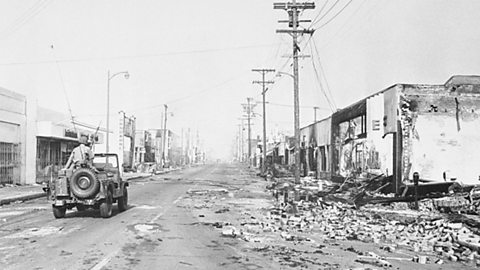Successes and failures, 1965 - 1975
After 1965, the civil rights movement paid more attention to the problems in the North. Here, thousands of black Americans lived in ghettoA poor part of a city that is usually occupied by a minority group, sometimes purpose built. where they faced discriminationTo treat someone differently or unfairly because they belong to a particular group. in education and employment.
- Low employment rates led to:
- poor housing standards
- high personal debts
- increased illegal drug use
- Housing discrimination led to:
- struggling schools
- increases in crime
- institutional racism Racism which deliberately or unwittingly rests in the policies, procedures, operations and culture of public or private institutions. It can reinforce individual prejudices and be reinforced by them in return. led to:
- police brutality
- discrimination from authorities
- lack of government action
Race riots

In July 1964, race riotA violent disturbance of the peace that results from racial tension and hostility. started and spread to around 300 cities after an initial riot in New York. One of the most serious riots occurred in 1965 in a neighbourhood of Los Angeles called Watts, where black people faced poverty, unemployment and police brutality. A riot was triggered when a black man was arrested for drink driving, drawing the attention of a crowd. Around 35,000 people joined the riot and 34 people were killed during six days of violence.
The Kerner Report
The federal governmentThe central government in the USA, including the president, Congress and the Supreme Court. responded to the riots by setting up a commissionA group of people who are asked to investigate something. to investigate their causes. It was led by the governorA person who is elected to lead a stateтs government in the USA. of Illinois, Otto Kerner. His report suggested that the USA was dividing into separate white and black societies due to poverty and racism. It said that the riots were the result of poor living conditions, limited employment opportunities and failures by the police.
Kerner recommended that large amounts of money should be spent on social programmes to improve the lives of black people. However, his recommendations were not taken up due to a lack of government funds. The riots had played a major part in raising awareness of discrimination, but they had also frightened many moderate white supporters of the civil rights campaign.
Dr Martin Luther King Jnr and the North
From 1966, Martin Luther King Jnr.A Christian minister who believed in peaceful protest without using violence and who was a key figure in the US civil rights movement. began to focus on the urban North. He recognised that poverty was creating the same problems in the North that racism and racist laws had created in the South. King set up the Chicago Freedom Movement and moved into a tenement A large block of apartments, usually with poor-quality living conditions in a poor part of a city. in Chicago to connect with the people he was trying to help. The movement campaigned to improve education, housing and employment in Chicago.
Under Kingтs leadership, the Student Nonviolent Coordinating Committee SNCCStudent Nonviolent Coordinating Committee initially promoted non-violent protest. announced the Poor Peopleтs Campaign. This aimed to bring about improved welfare and education for the USAтs low income communities.
King was assassinated in April 1968, while he was attending a sanitation workersт strike. This event shocked the USA and led to nationwide riots.
Many people attended King's funeral and his assassination prompted President Lyndon B Johnson to pass a new Civil Rights Act in 1968. The act aimed to prevent housing discrimination. This was evidence of progress, but the civil rights movement had lost a strong leader who had brought focus to the civil rights movement.